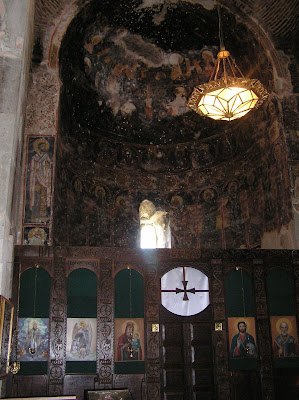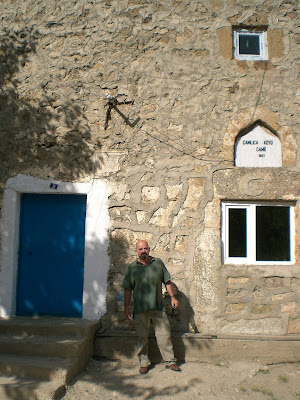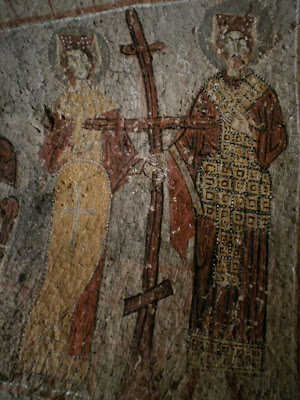
St. George--Tavispubleba Square
What a difference a year makes. I vividly recall last year's first impression of Georgia: a midnight flight out of Istanbul; a hard, bumpy, 2:30 AM landing on a darkened Tbilisi airport runway; no gates, we exited the plane onto the tarmac and walked across to a drab block building; we crushed together trying to reach one of the 2 drowsy customs agents; once processed, we ran the gauntlet of taxi drivers clamoring for our business; a ride into the city in a sputtering Lada, circa 1975; past old men manning makeshift sidewalk cigarette stands beneath a single light bulb...
It was so atmospheric that I was actually looking forward to the experience again this year. I was to be disappointed. A sleek, modern, well-lit, state-of-the-art terminal, complete with 4 gates, has replaced the old block building. Going through customs was a snap, and I entered onto a spacious, airy lobby, complete with shops. A new Volkswagen Passat served as my taxi into the city.
+1018.jpg)
The new Presidential Palace taking shape
Tbilisi itself, in the morning light, offered even more surprises. New construction was going up all over the place. As I would learn, the city was undergoing a genuine estate boom. The monument I observed under construction last year in the center of Tavispubleba Square is now complete: a golden statue of St. George is now in place in the very spot once occupied by the obligatory statue of Lenin. It is satisfying to note that Lenin is but a flash in the historical pan, while the Faith of St. George is alive and flourishing some 1700 years after his death.
On the other side of the river, a grand Presidential Palace is rising above the bluff. The jury is still out on this one--we'll just have to wait and see--but by and large, new architecture seems rooted in tradition, and offers a sharp repudiation the garishness and monumentality of the Soviet era. Historic Georgian-style buildings are being restored and reconditioned. Communist-era eyesores are coming down. Former churches that were closed by the Soviets and put to other uses are being painstaking restored to the former condition.
+036.jpg)
Bolnisi Sioni Church
But beyond that, I noticed improvements in the little things, as well. Tbilisi is noticeably cleaner than before. Regular garbage pick-up seems to be underway, the streets seem much less littered, and new green sidewalk trash receptacles dot the downtown area. Where my son and I had hiked along twisting and overgrown trails below the walls of the old fortress, there are now paved pathways, with observation platforms, lights and trash cans. Don't get me wrong, Tbilisi is in no danger of becoming another Prague--there's enough scruffiness to last for decades--but it does seem to be a city becoming really alive once more.
I was not to join my tour group until the next day, so I decided to put my free day to good use. I hired a car and driver and we set out for Bolnisi. I particularly wanted to visit the churches at Bolnisi Sioni and Dmanisi. I have found the Georgian style perhaps the most beautiful and awe-inspiring of the various Orthodox traditions. They are particularly noted for their soaring conical domes. But these churches--among Georgia's very oldest--are without domes. The early churches were simple basilicas. In later centuries, these domes would often be added to existing basilicas. I was eager to see these earliest churches, a subtle reminder that a dome does not necessarily an Orthodox church make.

St. Nino--Bolnisi Sioni Church
My driver was a young man named George. We set out for Bolsini in his late model Volvo station wagon. Our conversation was limited--his English was halting, my Georgian began and ended at "hello." Like most Georgians, he was a big fan of the U.S. and George Bush; Russia, not so much. George exclaimed "Russia...still Communist...crazy!", as he hit his head with the palm of his hand in exasperation. He was proud father, showing me a picture of his 2 year old son, whom he named Levon, after his own father.

Bolnisi Sioni Church
The town of Bolnisi was a pleasant surprise: wide streets lined with plane trees, attractive, colorful houses and shops, and no litter. The potato harvest was underway on the surrounding farmland. Horses pulling plows were turning up the potatoes, and then men and women were bent over piling the potatoes into long rows for loading. Some were resting and eating in the shade of the plane trees along the road. Old men or young boys drove horse-drawn carts filled with produce. In fact, these carts outnumbered automobiles along the road. All of this is picturesque and would have made an ideal tour-book type photograph to illustrate how "quaint" things are in lesser developed countries. I determined to take no such pictures. For these Georgians, in the timeless rhythm of their lives, often have more dignity than those of us in the advanced West. I would not demean them by using them as backdrops for a quaint photo-op.
Bolnisi Sioni Church dates back to the 5th Century, with the oldest religious inscriptions intact in Georgia. Sioni Church is on the outskirts of town, in a separate village, actually. From the outside it appears to be just a big barn of a building. The inside of the 3 nave basilica, however, was simply glorious. It was late morning, on a Thursday, and the church was active. Candles were flickering everywhere (to which I added my own), a priest was in and out and talking to members of his flock, young people were coming in to light candles and pray before the icons. I was reminded afresh of the stark difference between the Protestant and Orthodox mindset of "church." And to me, this is perhaps the greatest hurdle we face as Orthodoxy attempts to take root in American culture. For despite our intellectual agreement with the premise that church = people, our behavior often betrays our belief that "church" is something you do on Sunday, and the church building is seen in a utilitarian context almost--a place you go on Sunday. For Orthodox, churches are holy places, always open for business, so to speak. A closed church, waiting to be opened for Sunday services, is a foreign concept in Georgia. As someone--perhaps Fr. Stephen Freeman--said, Orthodox worship is like getting on a train that never stops. Churches are open, day in, day out, the cycles of prayer and worship continue on, as worshippers perform their devotions throughout the week, and at all hours.
+545.jpg)
Dmanisi Church
The church at Dmanisi was much more remote, not far from the Armenian border. Dmanisi was once the site of a substantial city, though now only the church remains. At least one priest was in residence, and there was a certain amount of activity here. The church's barn-like appearance was deceptive--I continued to be amazed at the height of the vaulted ceilings within.
Between Bolnisi and Dmanisi, George suggested that we visit the Tsugrugasheni Church. Occupying a rocky hilltop, Tsugrugasheni is a fine example of Georgian church-building during the height of the kingdom. The church has suffered mightily through the years, and is currently undergoing some much-needed restorative work. A service was going on when we arrived, and a number of people were crowded within the small nave. I had no idea as to what service it was exactly, or what was being chanted, until he got to the "alleuia, alleuia, alleuia." That, I know. I was moved by the incredibly beautiful silver icon of St. George. A woman came in and seemed near collapse from the walk up the hill. The priest sat next to her, offered her some water and ministered to her. She seemed better, so we eased out of the church and slowly made our way back to the modern world.

Tsugrugasheni Church
+541.jpg)

+575.jpg)
+517.jpg)
+488.jpg)
+022.jpg)
+496.jpg)
+501.jpg)

+512.jpg)

+005.jpg)
+004.jpg)
+445.jpg)
+451.jpg)
+450.jpg)
+448.jpg)



+459.jpg)
+395.jpg)
+409.jpg)
+400.jpg)
+411.jpg)
+429.jpg)
+421.jpg)
+439.jpg)

+070.jpg)
+079.jpg)
+081.jpg)
+083.jpg)

+087.jpg)
+130.jpg)
+097.jpg)
+094.jpg)
+102.jpg)
+389.jpg)
+326.jpg)

+294.jpg)
+329.jpg)
+320.jpg)
+316.jpg)
+315.jpg)

+376.jpg)


+314.jpg)
+295.jpg)